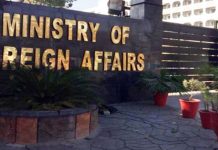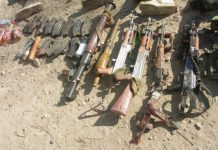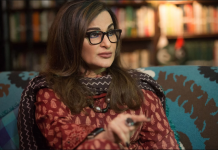BERLIN: The first group of soldiers from Germany arrived in Lithuania on Sunday as part of a NATO initiative to boost its eastern flank in the face of Russia’s war against Ukraine.
Around 100 armored infantry troops and almost 40 military vehicles were transferred by ship across the Baltic Sea to the NATO country to help develop what the alliance calls an “enhanced forward presence.”
Germany is to lead a combat brigade of 3,000 to 5,000 soldiers for Lithuania, and the German concept envisages stationing weapons, ammunition and command staff on the ground.
After arriving at the port of the city of Klaipeda, the troop contingent set off for the Lithuanian military base in Rukla. The majority of the soldiers will remain on standby in Germany.
In Klaipeda, German Brig. Gen. Christian Nawrat spoke of a “clear reassurance of solidarity towards Lithuania in the alliance.”
Lithuanian Brig. Gen. Arturas Radvilas said that by establishing the brigade, Germany was the first to take “such an important practical step” in the Baltic region.
Lithuania borders Russia’s Baltic Sea exclave of Kaliningrad as well as Russia’s ally Belarus. Currently, a German-led NATO battalion with about 1,600 soldiers is stationed in the Baltic EU state in northeastern Europe.
Meanwhile, President Volodymyr Zelenskiy marked progress in a counter-offensive Ukraine that began last week, thanking his forces for taking two settlements in the south, a third in the east, as well as additional territory in the east of the country.
He did not say precisely where the territories were and provided no timeline except to say that he had received “good reports” at a meeting on Sunday from his military commanders and head of intelligence.
In his nightly video address, Zelenskiy thanked his forces for liberating a settlement in the eastern Donetsk region, the taking of “certain heights” also in an eastern area in the Lysychansk-Siversk direction and for liberating two southern settlements.
Kyrylo Tymoshenko, deputy head of the president’s office, earlier on Sunday posted an image of soldiers raising the Ukrainian flag over a village he labeled as being in the southern area that is the main focus of the counter-offensive.
“Vysokopillya. Kherson region. Ukraine. Today,” Tymoshenko wrote in a Facebook post over a photo of three soldiers on rooftops, one of them fixing a Ukrainian flag to a post.
Located just north of the Crimean peninsula, which Moscow invaded and annexed in February and March 2014, the Kherson region was seized by Russian forces early in the current conflict.
Lysychansk was claimed by pro-Russian separatists in the Luhansk region in early July as part of a battle over the coalmining Donbas area in eastern Ukraine, which also includes Siversk.
Monday, Ukraine made its boldest claim yet of success on the battlefield in its week-old counter-offensive against Russian forces in the south, while European markets went into free-fall after Russia kept its main gas pipeline to Germany shut.
Following days of silence about their new offensive, Ukrainian officials posted an image online of three soldiers raising a flag over a town in Kherson province, a southern region occupied by Russia since the war’s early days.
The image of the flag being fixed to a pole on a rooftop, purportedly in Vysokopyllya in the north of Kherson, was released as President Volodymyr Zelenskiy said Ukrainian forces had captured two towns in the south and one in the east. In an overnight address, he did not identify the locations.
After months of enduring punishing Russian artillery assaults in the east, Ukraine has at last begun its long-awaited counter-attack, its biggest since it repelled Russian forces from the outskirts of Kyiv in March. –Agencies




